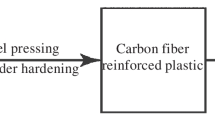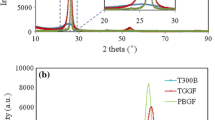Abstract
Because of their unusually large specific surface area (SSA), Activated Carbon Fibers (ACF’s) have a huge density of micropores and defects. The Raman scattering technique and low-temperature dc electrical conductivity measurements were used as characterization tools to study the disorder in ACF’s with SSA ranging from 1000 m2/g to 3000 m2/g. Two peaks were observed in every Raman spectrum for ACF’s and they could be identified with the disorder-induced peak near ∼1360 cm−1 and the Breit–Wigner–Fano peak near ∼1610 cm−1 associated with the Raman-active E2g2 mode of graphite. The graphitic nature of the ACF’s is shown by the presence of a well-defined graphitic structure with La values of 20–30 Å. We observed that the Raman scattering showed more sensitivity to the precursor materials than to the SSA of the ACF’s. From 4 K to room temperature, the dc electrical resistivity in ACF’s is observed to follow the exp [(T0/T)1/2] functional form and it can be accounted for by a charge-energy-limited tunneling conduction mechanism. Coulomb-gap conduction and n-dimensional (n ≤ 3) variable-range hopping conduction models were also considered but they were found to give unphysical values for their parameters.
Similar content being viewed by others
References
A. Nishino, Tanso (Carbon Society of Japan) 132, 57 (1988).
K. Kaneko and N. Shindo, Carbon 27, 815 (1989).
E. Tanaka, Fuel and Combustion 54, 241 (1987).
M. Smíšek and S. Černý, Active Carbon: Manufacture, Properties and Applications (American Elsevier Publishing Company, New York, 1967).
D. D. Saperstein, J. Phys. Chem. 90, 3883 (1986).
R. Mcintosh, R. S. Haines, and G. C. Benson, J. Chem. Phys. 15, 17 (1947).
W. W. Smeltzer and R. Mcintosh, Can. J. Chem. 31, 1239 (1953).
S. L. di Vittorio, M. S. Dresselhaus, M. Endo, J. P. Issi, L. Piraux, and V. Bayot, J. Mater. Res. 6, 778 (1991).
K. Kuriyama and M. S. Dresselhaus, J. Mater. Res. 6, 1040 (1991).
B. S. Elman, M. S. Dresselhaus, G. Dresselhaus, E. W. Maby, and H. Mazurek, Phys. Rev. B 24, 1027 (1981).
M.S. Dresselhaus and G. Dresselhaus, in Light Scattering in Solids III, Topics in Applied Physics, edited by M. Cardona and G. Giintherodt (Springer, Berlin, Heidelberg, 1982), Vol. 51, p. 3.
T. C. Chieu, M. S. Dresselhaus, and M. Endo, Phys. Rev. B 26, 5867 (1982).
J. R. Dacey, D. F. Quinn, and J. T. Gallagher, Carbon 4, 73 (1966).
F. Carmona, P. Delhaès, G. Keryer, and J. P. Manceau, Solid State Commun. 14, 1183 (1974).
T. Hanawa and J. Kakinoki, Carbon 1, 403 (1964).
J. Heremans, Carbon 23, 431 (1985).
P. Delhaès and F. Carmona, in Chemistry and Physics of Carbon, edited by P. L. Walker, Jr. and P. A. Thrower (Marcel Dekker, Inc., New York, 1981), Vol. 17, p. 89.
Dennis F. Baker and Robert H. Bragg, Phys. Rev. B 28, 2219 (1983).
N. F. Mott, Conduction in Non-Crystalline Materials (Oxford University Press, New York, 1987).
R. M. Hill, Phys. Status Solidi A35, K29 (1976).
A. G. Zabrodskii, Sov. Phys.-Semicond. 11, 345 (1977).
W. H. Press, B. P. Flannery, S. A. Teukolsky, and W. T. Vetterling, Numerical Recipes in C (Cambridge University Press, New York, 1988).
A. W. P. Fung, Characterization of Activated Carbon Fibers, Master’s Thesis, Department of Electrical Engineering and Computer Science, MIT, 1991.
D. S. Knight and W. B. White, J. Mater. Res. 4, 385 (1989).
M. S. Dresselhaus, G. Dresselhaus, K. Sugihara, I. L. Spain, and H. A. Goldberg, Graphite Fibers and Filaments (Springer, Berlin, Heidelberg, 1988).
C. T. Chan, K. M. Ho, and W. A. Kamitak hara, Phys. Rev. B 36, 3499 (1987).
M. Endo (unpublished).
A. L. Efros and B. I. Shklovskii, J. Phys. C8, L49 (1975).
A. G. Zabrodskii, Sov. Phys.-Semicond. 14, 781 (1980).
B. Abeles, P. Sheng, M. D. Courts, and Y. Arie, Adv. Phys. 24, 407 (1975).
B. I. Shklovskii and A. L. Efros, Electronic Properties of Doped Semiconductors (Springer, Berlin, Heidelberg, 1984).
S. L. di Vittorio, M. S. Dresselhaus, T. Enoki, M. Endo, and T. Nakajima, Phys. Rev. (1992), in preparation.
B. T. Kelly, Physics of Graphite (Applied Science, London, 1981).
C. J. Adkins, in Hopping and Related Phenomena, edited by H. Fritzsche and M. Pollak (World Scientific Publishing Company, Singapore, 1990), p. 93.
B. I. Shklovskii, Sov. Phys.-Semicond. 6, 1964 (1973).
Author information
Authors and Affiliations
Rights and permissions
About this article
Cite this article
Fung, A.W.P., Rao, A.M., Kuriyama, K. et al. Raman scattering and electrical conductivity in highly disordered activated carbon fibers. Journal of Materials Research 8, 489–500 (1993). https://doi.org/10.1557/JMR.1993.0489
Received:
Accepted:
Published:
Issue Date:
DOI: https://doi.org/10.1557/JMR.1993.0489




